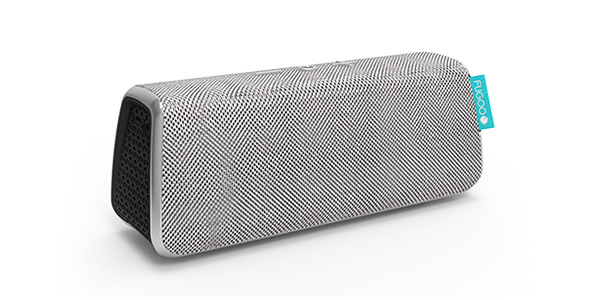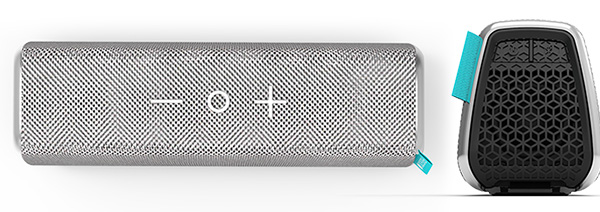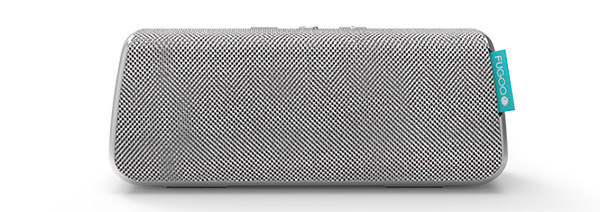Fugoo Style Bluetooth Speaker Review: Best-in-Class Sound and Features
Fugoo's portable Bluetooth speaker bests the competition in all the areas that matter: ruggedness, battery life and sound quality.

Design

Fugoo's small stature belies its abilities. At 7.4 x 2.9 x 2.3 inches, the Fugoo is noticeably smaller than other leading portable Bluetooth speakers that cost around $200, such as the 7.1 x 2.6-inch cylinder of the UE Boom and 3.6 x 7 x 2.1-inch Klipsch Gig. It's lighter, too; the Fugoo's 1.1 pounds shave a few ounces off the 1.3-pound UE Boom and the 1.4-pound Gig.
Fugoo offers three different "jackets" for the speaker: Sport, Tough and Style. We tested the Style, which focuses its aesthetics on a silver mesh that covers the speaker; additional jackets cost $39 each. The core remains the same, packed with two tweeters for treble, two mid/woofer drivers for the midrange and bass tones, and two passive radiators for additional low-end frequencies.
The company opted for only essential buttons on the device. On the top, you'll find buttons to raise and lower the volume or answer and end calls. One side of the speaker features the power button and a Bluetooth connection button. The other side has a microUSB port and a 3.5mm auxiliary input for connecting directly to your device by a wire.
MORE: Our Favorite Soundbar Speakers
We're all for minimalism, but one of the Fugoo's few shortcomings is a lack of visual cues about its status. Besides a light that indicates the device is powered on, you have to rely on voice guidance to find out about battery-life level and connection status. Like the Jabra Solemate, the voice guidance is set to an annoyingly loud level and can't be turned down. You can only turn it off completely.
Though Fugoo doesn't offer an app like the UE Boom to control the device, you can buy a $40 waterproof remote to control the speaker from across the room (and it doubles as a bottle opener for good measure). Fugoo also offers software you can download to your computer that allows for firmware updates, a nice touch that should help the speaker keep up with newer trends in features.
Weatherproofing

The Fugoo Style can handle just about anything you throw at it — literally. With an IPX rating of 67, the speaker is both dust proof and waterproof. Fugoo says you can hold the device under one meter of water for 30 minutes before it will stop working. That's serious toughness. Compare that to the UE Boom, which has an IPX rating of 4; it can withstand a splash of water, but not a dunking.
Get instant access to breaking news, the hottest reviews, great deals and helpful tips.
Setup and Use
The Fugoo paired quickly with both iOS and Android devices. To put the speaker in discovery mode, you push the Bluetooth button on the side for a couple of seconds. In iOS, go to Settings > Bluetooth, where the Fugoo Speaker should appear under Devices. On an Android device, you just have to go to Settings and look for the speaker listed in Available Devices. Unlike the Klipsch Gig and UE Boom, the Fugoo doesn't include near-field communication (NFC), which allows connection by touching the speaker to your mobile device. But since few people take advantage of NFC, that's not a major shortcoming.
Fugoo claims a range of 33 feet for Bluetooth connectivity, and we found that to be accurate indoors and out — particularly impressive for the outdoors considering other models in the class often break up at 10 to 15 feet.
MORE: Best Bluetooth Speakers Available Now
Audio Performance

From the first listen, the Fugoo impressed with its full sound. Unlike most other portable Bluetooth speakers that cost about $200, the Fugoo hits the highs and the lows equally well. On St. Vincent's "Digital Witness," the Fugoo nicely balanced the deep bass riffs with the vocals and the bright horns. It crisply reproduced the acoustic guitar picking on Beck's "Heart Is a Drum."
The lithe flutes and strings at the beginning of Mendelssohn's overture to "A Midsummer Night's Dream" came across with depth that other Bluetooth speakers struggle to equal. Fugoo also handled the low-end growl on the Beastie Boys' classic "Shake Your Rump" with more detail than any portable Bluetooth speaker we've heard. Compare this with the previous best in overall sound for $200 portable Bluetooth speakers, the UE Boom, which did well with vocals and treble tones, but lacked the rich bass needed for the full sound package.
Beyond the frequencies it can reproduce, the Fugoo spreads the sound widely, particularly impressive given its small stature. This is great when you're sharing your music with others — no need for everyone to sit directly in front of the speaker to enjoy the sound.
Speakerphone
The Fugoo includes the latest in speakerphone tricks, too, such as integration with Siri and Google Now. To activate voice commands through Siri, you hold the center button for a few seconds, and then you'll hear the familiar chime that indicates Siri is listening.
We found call quality with the Fugoo to be on a par with the best portable Bluetooth speakers in the price class, the UE Boom. Calls were clear on both ends when the speaker was about arm's length away, and microphone quality was on a par with the iPhone's built-in unit.
Battery Life
Fugoo claims its speaker can play for 40 hours at 50-percent volume. That's a Superman-sized leap ahead of the competition. The UE Boom was considered excellent with 15 hours of playback on a single charge. In real-world testing, we found the claims to be consistent with reality. After about 20 hours of use over several days, the speaker reported the battery level to be "about half."
Verdict

No other portable Bluetooth speaker that costs $200 can match the Fugoo's combination of sound quality, battery life and waterproofing. In fact, few devices that cost $300 can match the Fugoo's audio performance. If you're in the market for a portable Bluetooth speaker, we highly recommend the Fugoo. The real question is which jacket to get: Style, Sport or Tough.

Michael Gowan is a freelance technology journalist covering soundbars, TVs, and wireless speakers of all kinds of shapes and sizes for Tom’s Guide. He has written hundreds of product reviews, focusing on sound quality and value to help shoppers make informed buying decisions. Micheal has written about music and consumer technology for more than 25 years. His work has appeared in publications including CNN, Wired, Men’s Journal, PC World and Macworld. When Michael’s not reviewing speakers, he’s probably listening to one anyway.
